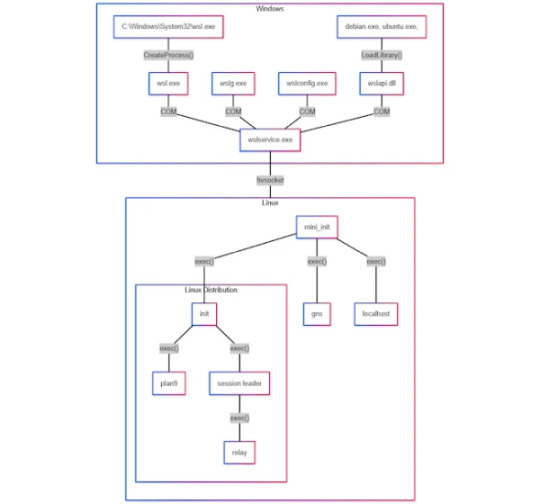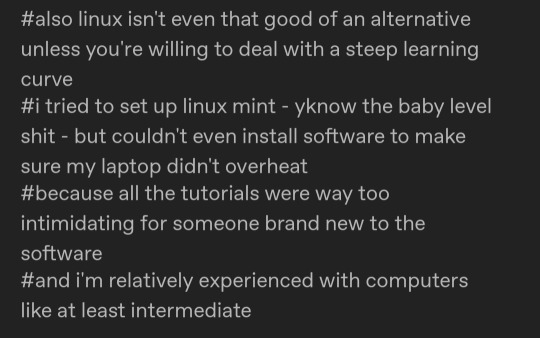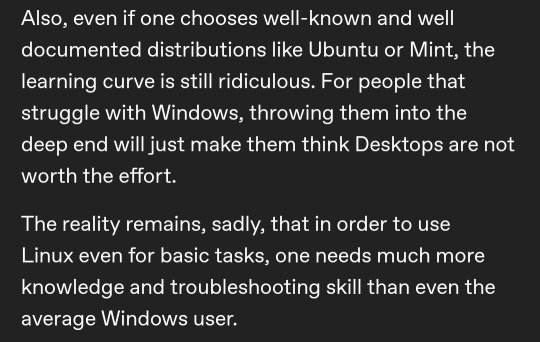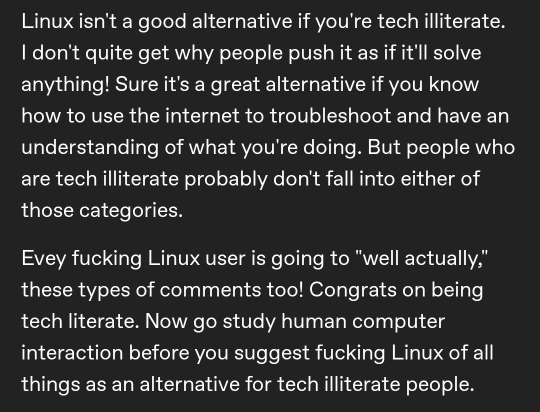#Microsoft-Windows-Subsystem-Linux
Explore tagged Tumblr posts
Text

«THE WINDOWS SUBSYSTEM FOR LINUX IS NOW OPEN SOURCE»
🔵 blogs.windows.com
Неплохо, неплохо. Даже себя легонько потроллили с этим "Когда оно будет в опенсорсе". Да и иконочку с пингвинчиком симпатичную сделали.
0 notes
Text
WSL recently went open source but even before then it was really good.
Windows Subsystem for Linux is a thing by microsoft which just allows you to run linux inside of your windows PC. I just used it whenever i needed some command line tooling or shit that windows doesn't have (grep, wc, openssl) but i found out only a billion years later it can run full gui apps (just download them and run them from the command line) or you can also run an Entire Desktop environment to basically just have a Linux system inside of your windows installation without any virtual machines or messing about with dual booting or partitioning.
WSL will run a lot worse than normal linux however its (i think) much easier to set up and you can access all your normal windows files from it as well.
It would be good to try if you want to switch to linux but you wanna try it out, however i dont think i have any windows devices anymore to see how well it works and how easy it is to set up a DE
11 notes
·
View notes
Text
What is the most awesome Microsoft product? Why?
The “most awesome” Microsoft product depends on your needs, but here are some top contenders and why they stand out:
Top Microsoft Products and Their Awesome Features
1. Microsoft Excel
Why? It’s the ultimate tool for data analysis, automation (with Power Query & VBA), and visualization (Power Pivot, PivotTables).
Game-changer feature: Excel’s Power Query and dynamic arrays revolutionized how users clean and analyze data.
2. Visual Studio Code (VS Code)
Why? A lightweight, free, and extensible code editor loved by developers.
Game-changer feature: Its extensions marketplace (e.g., GitHub Copilot, Docker, Python support) makes it indispensable for devs.
3. Windows Subsystem for Linux (WSL)
Why? Lets you run a full Linux kernel inside Windows—perfect for developers.
Game-changer feature: WSL 2 with GPU acceleration and Docker support bridges the gap between Windows and Linux.
4. Azure (Microsoft Cloud)
Why? A powerhouse for AI, cloud computing, and enterprise solutions.
Game-changer feature: Azure OpenAI Service (GPT-4 integration) and AI-driven analytics make it a leader in cloud tech.
5. Microsoft Power BI
Why? Dominates business intelligence with intuitive dashboards and AI insights.
Game-changer feature: Natural language Q&A lets users ask data questions in plain English.
Honorable Mentions:
GitHub (owned by Microsoft) – The #1 platform for developers.
Microsoft Teams – Revolutionized remote work with deep Office 365 integration.
Xbox Game Pass – Netflix-style gaming with cloud streaming.
Final Verdict?
If you’re a developer, VS Code or WSL is unbeatable. If you’re into data, Excel or Power BI wins. For cutting-edge cloud/AI, Azure is king.
What’s your favorite?
If you need any Microsoft products, such as Windows , Office , Visual Studio, or Server , you can go and get it from our online store keyingo.com
8 notes
·
View notes
Text
The Windows Subsystem for Linux goes open source

Source: https://www.helpnetsecurity.com/2025/05/20/microsoft-wsl-open-sourced/
More info: https://blogs.windows.com/windowsdeveloper/2025/05/19/the-windows-subsystem-for-linux-is-now-open-source/
4 notes
·
View notes
Text
Microsoft veröffentlicht Installationsanleitung für Linux
Auf der Webseite von Microsoft ist neuerdings eine Installationsanleitung für Linux-Systeme vorzufinden. "Linux ist ein Betriebssystem, ähnlich wie Windows, aber mit vielen verschiedenen Versionen, da es quelloffen und vollständig anpassbar ist", erklärt der Softwarekonzern in der Anleitung einleitend – womöglich aus Sicherheitsgründen.
2 notes
·
View notes
Text
Alright, Long Rant Incoming:





there is NOTHING about Linux that is inherently (inherently) harder to learn than Windows.
this is part of the problem!!
Windows also has a command line. Windows also uses and depends on the BIOS. Windows is also a pain to install if it wasn't already on your machine. Windows is also crammed full of confusing and hard to understand subsystems!
(and for that last point, at least Linux's confusing subsystems are well-designed. most Windows users would never survive contact with the Windows registry...)
as someone who regularly uses both Windows and all sorts of Linux distros, I (at least personally) don't see any real difference in complexity. so if that's not the problem, then what is?
well, there's a few different causes of this:
Windows is the primary branch of an extremely powerful oligopoly, and so the vast majority of tech resources are based around it. every non-Apple computer you buy is going to have an OEM copy of Windows on it. every computer science class you attend will use Windows. most online tutorials assume you're using Windows. (This isn't even touching on software support, which is a related but different issue.)
computer literacy classes don't teach how to use text-based interfaces. this is a problem! just because microsoft doesn't want you to acknowledge the existence of the command prompt doesn't mean it isn't a key feature, and this is, in fact, a major source of Windows's design problems. (even Microsoft themselves seem to have realized this when they added a truly abysmal text-based package manager in Windows 10.)
the average contemporary consumer of tech hasn't been taught how to expect more from their machines than what they advertise on the surface level. this isn't to deride or shame those consumers; the blame lies with the corporations that are designing the interfaces they use. the tools I mentioned above do exist on Windows, but only out of obligation - if they could get away with it, Microsoft would happily lock those features entirely out of the hands of end users, just as mobile phone OSes have done for more than a decade. Linux, on the other hand, has no reason to hide its capabilities, and so it fully exposes them in a way that is jarring to those unaccustomed to it. the solution is, as always, more education.
Microsoft and Windows are just as guilty of causing the modern stagnation of tech literacy as Google and Apple. if there is ever a future where people can truly trust the tech that supports their lives, it will be using software that is free and open.
We need to lay more blame for "Kids don't know how computers work" at the feet of the people responsible: Google.
Google set out about a decade ago to push their (relatively unpopular) chromebooks by supplying them below-cost to schools for students, explicitly marketing them as being easy to restrict to certain activities, and in the offing, kids have now grown up in walled gardens, on glorified tablets that are designed to monetize and restrict every movement to maximize profit for one of the biggest companies in the world.
Tech literacy didn't mysteriously vanish, it was fucking murdered for profit.
78K notes
·
View notes
Text
0 notes
Link
0 notes
Quote
2025年05月20日 19時00分 フランスが「国連オープンソース原則」を支持する最初の中央政府となり19の組織も加わる 国際連合(国連)が採択したオープンソースに関するガイドライン「国連オープンソース原則」に、フランス政府が中央政府として初めて支持を表明しました。フランス政府が支持を表明するのと同時に、クリエイティブ・コモンズやメルセデス・ベンツ・グループなど19の組織も国連オープンソース原則に賛同しています。 France Becomes First Government to Endorse UN Open Source Principles, Joined by 19 Organizations | Le Bureau de L'informatique et des Communications https://unite.un.org/fr/news/france-becomes-first-government-endorse-un-open-source-principles-joined-19-organizations フランス政府の省庁において、情報通信システム分野の連携・調整を勧めるデジタル省庁間総局(DINUM)のFOSSプロジェクト・code.gouv.frが、2025年5月19日のMastodonへの投稿で、「フランスが国連オープンソース原則を支持する初の政府となり、19の組織が参加しました」と報告しました。 国連オープンソース原則とは、デジタルおよびテクノロジー分野での協力を促進する国連機関・Digital Technology Network(DTN)により採択された、国連内および世界規模でのオープンソース技術の協力と採用を促進するためのガイドラインです。DTNによって設立された実践コミュニティであるOpen Source Unitedは、国連の機関・基金・プログラム全体でオープンソース技術を進歩させるために活動しているとのこと。 国連オープンソース原則は以下の8項目で構成されています。 1:デフォルトでオープン……オープンソースをプロジェクトの標準的なアプローチにする。 2:貢献して返す……オープンソースへの積極的な参加を奨励する。 3:セキュア・バイ・デザイン……すべてのソフトウェアおよびプロジェクトでセキュリティを優先する。 4:包括的な参加とコミュニティ構築の促進……オープンソースへの多様で包括的な貢献を可能にし、促進する。 5:再利用性を考慮した設計……さまざまなプラットフォームやエコシステム間で相互運用可能なプロジェクトを設計する。 6:ドキュメントの提供……エンドユーザーや組織の責任者、開発者向けに徹底したドキュメントを提供する。 7:RISE(認識・インセンティブ・サポート・エンパワーメント)……個人やコミュニティが積極的に参加できるようにする。 8:持続可能性と規模拡大……国連システム内外における、進化するニーズを満たすソリューションの開発を支援する。 フランス政府と同時に、クリエイティブ・コモンズやメルセデス・ベンツ・グループ、WordPress財団、ゼンケンベルク自然史協会など19の組織も国連オープンソース原則に賛同しています。 フランスによる国連オープンソース原則の支持は、ソーシャルニュースサイトのHacker Newsでも大きな話題となっています。 France Endorses UN Open Source Principles | Hacker News https://news.ycombinator.com/item?id=44024759 あるユーザーは2年間にわたり、フランス国内すべての建物にIDキーを作成・配布して管理する政府のプロジェクトに取り組んできたと述べています。このプロジェクトではデータをオープンにして政府機関や都市、企業、市民が直接レジストリに書き込めるようにして、データベースの相互運用性を向上させることが目標となっているそうです。 別のユーザーは、「これは見せかけのものであり、実体がついてきません」と述べ、フランス政府がオープンソースを��ったのは今回が初めてではないものの、依然として公的資金の大部分は独占的なソフトウェアに費やされていると指摘。このコメントに対しては同意する意見もあれば、ゆっくりだが着実にオープンソースのツールが採用されつつあると擁護する意見もありました。 この記事のタイトルとURLをコピーする ・関連記事 スイスは政府機関が政府向けに作ったソフトウェアをすべてオープンソースにするよう義務づけている - GIGAZINE オープンソースプロジェクト「Easyjson」はロシアで開発されているとの指摘、アメリカ国防総省などでも使われており国家安全保障上のリスク大 - GIGAZINE MicrosoftがWindows Subsystem for Linux(WSL)をオープンソース化してコードをGitHubに公開 - GIGAZINE オープンソースエコシステムに投資された金額は2024年の1年間で1兆2000億円超 - GIGAZINE オープンソースAIを定義する「OSAID」のバージョン1.0が公開、MetaのLlamaはオープンソースAIに合致せず - GIGAZINE GitHubがオープンソース開発にまつわる8400件のアンケート結果を公開、セキュリティを重視しAI利用が増加 - GIGAZINE ゼロから立ち上げてコミュニティから高く評価されたオープンソースプロジェクトがMicrosoftによってフォークされ自信喪失した開発者の話 - GIGAZINE 国連がAIに関する初の世界決議を全��一致で採択、個人情報の保護・AIのリスク監視など - GIGAZINE 国連のAI諮問機関が「人類のためのAI統治」に関する7つの提言を発表 - GIGAZINE ・関連コンテンツ 国連がAIに関する初の世界決議を全会一致で採択、個人情報の保護・AIのリスク監視など ドイツ新政権が「公共の場での生体認証による監視の禁止」を発表、監視の規制が欧州全体に広がる可能性も 脆弱性管理を担うCVEプログラムの運営資金が2025年4月16日で失効することが明らかに トランプ政権による政府公式ウェブサイトの削除や変更はGitHubでリアルタイムで監視可能 日本やアメリカなど18カ国がAIの安全開発ガイドラインを共同発表 スイスは政府機関が政府向けに作ったソフトウェアをすべてオープンソースにするよう義務づけている 「税金で作ったソフトウェアのコードは公開されるべき」という主張に3万人以上が賛同、日本からも署名可能 Linux Foundationが「オープンなメタバース」を支援する団体「Open Metaverse Foundation」の設立を発表
フランスが「国連オープンソース原則」を支持する最初の中央政府となり19の組織も加わる - GIGAZINE
0 notes
Text
Microsoft open-sources the Windows Subsystem for Linux
http://i.securitythinkingcap.com/TKtCbJ
0 notes
Text
Windows Subsystem for Linux (WSL): Cuộc cách mạng mã nguồn mở đã đến! #WSL #Opensource #Microsoft #Linux #Windows
## Windows Subsystem for Linux (WSL): Cuộc cách mạng mã nguồn mở đã đến! #WSL #Opensource #Microsoft #Linux #Windows Microsoft đã chính thức công bố Windows Subsystem for Linux (WSL) trở thành mã nguồn mở vào thứ Hai vừa qua. Đây là dấu mốc quan trọng khép lại hành trình nhiều năm, bắt đầu từ câu hỏi đơn giản nhưng đầy ý nghĩa trên kho lưu trữ Microsoft/WSL GitHub: Liệu WSL có nên là mã nguồn mở…
0 notes
Text
Microsoft takes Windows Subsystem for Linux open source after nearly a decade
Microsoft’s Windows Subsystem for Linux has become an important tool for developers and power users since it was introduced in the Windows 10 Anniversary Update back in 2016, giving them access to a built-in Linux command line and Linux applications from within Windows. The company has steadily improved WSL since then, improving performance, making it easier to install and use, and adding…
0 notes
Text
Red Hat Summit 2025: Microsoft Drives into Cloud Innovation

Microsoft at Red Hat Summit 2025
Microsoft is thrilled to announce that it will be a platinum sponsor of Red Hat Summit 2025, an IT community favourite. IT professionals can learn, collaborate, and build new technologies from the datacenter, public cloud, edge, and beyond at Red Hat Summit 2025, a major enterprise open source event. Microsoft's partnership with Red Hat is likely to be a highlight this year, displaying collaboration's power and inventive solutions.
This partnership has changed how organisations operate and serve customers throughout time. Red Hat's open-source leadership and Microsoft's cloud knowledge synergise to advance technology and help companies.
Red Hat's seamless integration with Microsoft Azure is a major benefit of the alliance. These connections let customers build, launch, and manage apps on a stable and flexible platform. Azure and Red Hat offer several tools for system modernisation and cloud-native app development. Red Hat OpenShift on Azure's scalability and security lets companies deploy containerised apps. Azure Red Hat Enterprise Linux is trustworthy for mission-critical apps.
Attend Red Hat Summit 2025 to learn about these technologies. Red Hat and Azure will benefit from Microsoft and Red Hat's new capabilities and integrations. These improvements in security and performance aim to meet organisations' digital needs.
WSL RHEL
This lets Red Hat Enterprise Linux use Microsoft Subsystem for Linux. WSL lets creators run Linux on Windows. RHEL for WSL lets developers run RHEL on Windows without a VM. With a free Red Hat Developer membership, developers may install the latest RHEL WSL image on their Windows PC and run Windows and RHEL concurrently.
Red Hat OpenShift Azure
Red Hat and Microsoft are enhancing security with Confidential Containers on Azure Red Hat OpenShift, available in public preview. Memory encryption and secure execution environments provide hardware-level workload security for healthcare and financial compliance. Enterprises may move from static service principals to dynamic, token-based credentials with Azure Red Hat OpenShift's managed identity in public preview.
Reduced operational complexity and security concerns enable container platform implementation in regulated environments. Azure Red Hat OpenShift has reached Spain's Central region and plans to expand to Microsoft Azure Government (MAG) and UAE Central by Q2 2025. Ddsv5 instance performance optimisation, enterprise-grade cluster-wide proxy, and OpenShift 4.16 compatibility are added. Red Hat OpenShift Virtualisation on Azure is also entering public preview, allowing customers to unify container and virtual machine administration on a single platform and speed up VM migration to Azure without restructuring.
RHEL landing area
Deploying, scaling, and administering RHEL instances on Azure uses Azure-specific system images. A landing zone lesson. Red Hat Satellite and Satellite Capsule automate software lifecycle and provide timely updates. Azure's on-demand capacity reservations ensure reliable availability in Azure regions, improving BCDR. Optimised identity management infrastructure deployments decrease replication failures and reduce latencies.
Azure Migrate application awareness and wave planning
By delivering technical and commercial insights for the whole application and categorising dependent resources into waves, the new application-aware methodology lets you pick Azure targets and tooling. A collection of dependent applications should be transferred to Azure for optimum cost and performance.
JBossEAP on AppService
Red Hat and Microsoft developed and maintain JBoss EAP on App Service, a managed tool for running business Java applications efficiently. Microsoft Azure recently made substantial changes to make JBoss EAP on App Service more inexpensive. JBoss EAP 8 offers a free tier, memory-optimized SKUs, and 60%+ license price reductions for Make monthly payments subscriptions and the soon-to-be-released Bring-Your-Own-Subscription to App Service.
JBoss EAP on Azure VMs
JBoss EAP on Azure Virtual Machines is currently GA with dependable solutions. Microsoft and Red Hat develop and maintain solutions. Automation templates for most basic resource provisioning tasks are available through the Azure Portal. The solutions include Azure Marketplace JBoss EAP VM images.
Red Hat Summit 2025 expectations
Red Hat Summit 2025 should be enjoyable with seminars, workshops, and presentations. Microsoft will offer professional opinions on many subjects. Unique announcements and product debuts may shape technology.
This is a rare chance to network with executives and discuss future projects. Mission: digital business success through innovation. Azure delivers the greatest technology and service to its customers.
Read about Red Hat on Azure
Explore Red Hat and Microsoft's cutting-edge solutions. Register today to attend the conference and chat to their specialists about how their cooperation may aid your organisation.
#RedHatSummit2025#RedHatSummit#AzureRedHatOpenShift#RedHat#RedHatEnterprise#RedHatEnterpriseLinux#technology#technologynews#TechNews#news#govindhtech
1 note
·
View note
Text
I think that Poweshell tools are as bad as they are because Microsoft designed the whole system to hide what tools you are using.
In linux, you have a "tool command arguments" syntax, which highlights what you are acting on and what third party you are involving. "Systemd start example", "git add folder", "Nano file"
In windows, it's verb-noun. "write-output text" "get-service" "new-object"
But it gets worse, because while in Linux, you get a known return type, in Windows, you don't. What a command returns is masked by a layer of text that doesn't match what's below. So if you want to do something like combine two commands... good luck.
I think Microsoft doesn't want you using tools in the operating system or understanding the subsystems in question. It doesn't want you understanding your system, and that shines through in the design choices.
If you need a verb and noun to start communication, you can't ask the subsystem "what can I do". Which is terrible for exploration.
0 notes
Text
Ubuntu available in Microsoft’s new WSL distribution format
We are happy to announce that Ubuntu on Windows Subsystem for Linux (WSL) is now available in Microsoft’s new tar-based distribution architecture. Ubuntu has been a widely used Linux distribution on WSL, offering a familiar development environment for many users. This new distribution architecture for WSL will make adoption easier in enterprise environments by enabling image customization and…
0 notes
Text
Pengwin(旧wlinux)環境構築ガイド - WSLを徹底カスタマイズ
Pengwinとは:WSL特化型Linuxディストリビューション Pengwin(旧wlinux)は、Windows Subsystem for Linux(WSL)向けに開発された商用Linuxディストリビューションです。 Debianをベースに、WSL環境での使いやすさを重視して設計されています。 Microsoft Storeから直接インストールでき、WindowsとLinuxのシームレスな連携を実現します。 Microsoft StoreからPengwinをインストール Microsoft…
0 notes